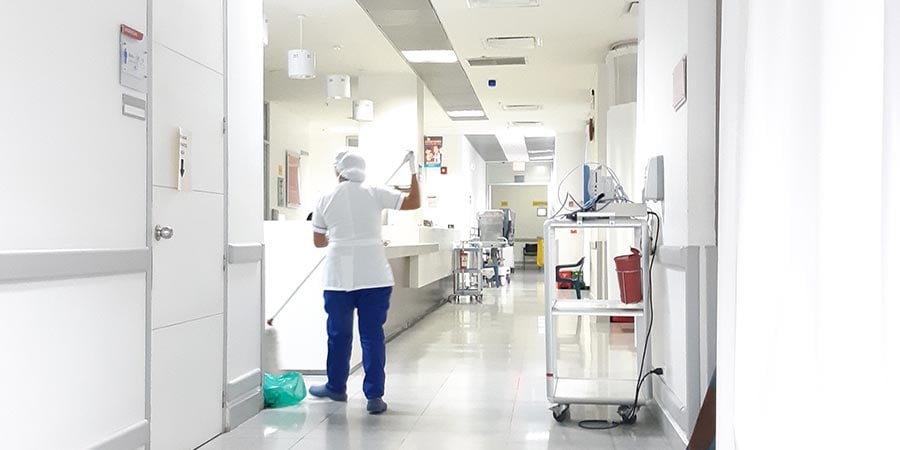Share this
Environmental Guidelines for Hospital Infection Control
by HEPACART on May 05, 2022
Get the sick well and keep the well healthy.
Hospitals are, by their nature, under a constant influx of germs. It’s up to the staff, all the staff, in the hospital to keep those germs out entirely, quarantine them if they get in, and destroy them if possible. Because germs, viruses, bacteria, and all manner of pathogens are quite good at finding a way to survive and infect, hospital infection control has to attack the problem from a variety of vantage points.
We’ve written before about creating an Infection Prevention and Control Team, as well as the Infection Risk Control Assessment (ICRA), but here we’re going to go over every aspect of hospital infection control, from air quality to scrubbing hospital equipment.
Why is Hospital Infection Control so Important?
If you’re a facility manager or a nurse, you probably already know the answer to this question, but we’re going to hammer it home anyway. It’s easy to get into a routine or let things slide after doing the same actions for so long, and everyone can use a reminder of just how much is involved in infection control.
According to the CDC there was about a 24% increase in central line-associated bloodstream infections (CLABSI) between 2019 and 2020, with the largest increases seen in the ICU (50%). The report also states there was a “15% increase in hospital-onset MRSA bacteremia between 2019 and 2020.” Covid-19 placed a huge strain on resources, a strain that many hospitals are still struggling to recover from.
The point is that Covid-19 taught a hard lesson about the importance of infection control. Hospitals not only had to battle the then mysterious disease with no vaccine, but had to deal with a huge influx of patients they couldn’t risk infecting, and they all needed specialized equipment that had to be cleaned before every use. If there was any major test that infection control policies and procedures had to face, Covid was it.
What’s Involved in Environmental Hospital Infection Control?
The CDC says that infection control “prevents or stops the spread of infections in healthcare settings.” That’s a general statement that requires lots of specific actions. When it comes to the environmental factors that can cause harm to patients, the issues go beyond germs. Dust and construction debris can be incredibly damaging, especially if older infrastructure is being torn down and substances like asbestos are being released into the air. How can you protect your hospital’s air quality?

1. HVAC Systems
Air conditioning and heating maintain a comfortable atmosphere for hospital residents, but the HVAC system can be dangerous if it’s also spreading pathogens and contaminants through the air. In a hospital setting, HVAC systems must have heavy-duty HEPA filtration to keep germs from making their way around the building.
2. Patient Isolation
Some patients will need to be in negative pressure rooms, which keep the air in the room from making its way out. These are called airborne infection isolation (AII) rooms. They may also require an anteroom and UV disinfection, too.
3. Maintenance and Construction
If there is any renovating, maintenance, construction, or other work that requires work on a facility’s infrastructure, dust and debris can make their way into the air. Now, the construction area may be isolated, but don’t forget that pollutants can hitch a ride on the workers. Dust containment units will keep the harmful stuff out of the air, but the construction crew will have to be careful not to bring contaminants with them when they walk out.
4. Water
When staff and visitors (and anyone, really) are interacting with patients, they must take appropriate precautions. Hand washing is the number one way to keep from spreading pathogens to the infirmed and vice versa. As always, hand washing is preferable Don’t forget that the water must be safe! Water tanks that don’t get used often can have bacteria or mold growing in them, so water supplies must be monitored and disinfected.
5. Patient Care Equipment
Just about every surface in a hospital will have to get cleaned sooner or later, but some surfaces are more crucial than others. A ceiling tile doesn’t have to be as clean as a scalpel, for example. Patient care equipment is usually broken into three parts in order of how important they are to keep clean:
- A. Critical items: Objects like surgical instruments.
- B. Semi-critical: Devices or materials that come into contact with mucous membranes or non-intact skin.
- C. Non-critical: Devices or items that only contact skin.
All these items should be sterilized, but priority is for critical items first, of course. Each item may have a cleaning product that works best with it, and UV disinfection is another excellent germ-fighting tool. Remember that cleaning tools themselves need to be cleaned! Mops can get moldy fast unless they’re properly washed.
6. Patient Care Environment
As for the patient environment, airborne infection isolation rooms need to have negative pressure, and protective environment rooms need to have positive pressure. The use of disinfectants and UV or FAR-UV light to destroy pathogens will work to keep the patient areas clean. Also, where patients are placed in a hospital is essential. Isolating more contagious or dangerous illnesses will prevent their spread. The more severe the illness or susceptibility to infection, the more isolated the patient must be.
7. Textile Handling
Depending on the nature of the illness or injury the patient has suffered, there may be personal protective equipment (PPE) that must be worn. This includes:
- Disposable, single-use gloves
- Surgical masks
- Respiratory masks
- Goggles
- Gowns
- Aprons
- Head covers
- Shoe covers
If the item is disposable, it has to be disposed of properly. Not any old trash can will do! And don’t forget that behavior helps prevent disease transmission, too. Covering coughs or sneezes, washing hands right after coughing or sneezing, and throwing away tissues immediately are a must!
But it’s not just the stuff you and your staff wear that can harbor germs. Items like curtains and sheets can absorb droplets and germs, too. On-site laundry facilities will need to handle constant cleaning of such washable items.
Download HEPACART®’s Guide to Hospital Infection Control
Hospitals need the clearest air of all, and it takes every staff member working together to keep it that way! Download our Practical Guide To Infection Control For Healthcare Facilities to read about all the ways infection control works to contain and eliminate contaminants, germs, and other threats. HEPACART is ready to partner with you to keep your facility safe by providing filtration systems, isolation walls, and UV disinfection systems, as well as our experience and expertise in designing and creating tools that clear the air.
Resources:



